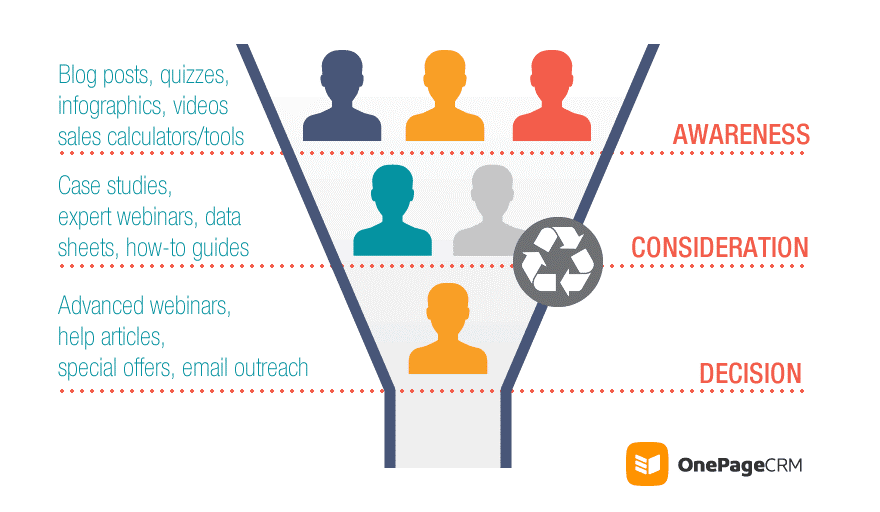How do you solve a problem like sales and marketing alignment? (Part 2)
So how can you influence buyers early on in the process?’
Ross
Barker, Bridge
As we share what makes sales and marketing alignment happen, it’s high time that the lead player stepped into the limelight.
Let’s give a warm welcome to the B2B Buyer.
So far, we’ve been looking within organisations for answers to the challenge of smarketing – charting the cultural and organisational rifts that can separate sales and marketing departments (‘SMarketing – holy grail or pandora’ s box?‘) and focussing on organisational ways to align the two sides of the same coin (‘How do you solve a problem part 1‘).
But now we’re going to cast our gaze beyond your business and look at ways that placing the buyer at the heart of the drama can produce a happy ending: a win-win for both sales and marketing.
The changing face of the B2B buyer
The fact is that the modern B2B buyer journeys much further down the sales pipeline until they appreciate the involvement of a salesperson.
What they now expect is to receive a warm welcome, lots of helpful advice and all the info they need online, via your website, webinars, social media profiles and so on.
- According to Marketo, at least 50% of the leads in any sales funnel are nowhere near being ready to buy.
- Research from Aberdeen tells us that modern B2B prospects make or receive an average of ten marketing ‘touches’ from the time they enter the funnel to the time they are finally converted to a customer by a salesperson.
- And other studies suggest that as much as 90% of the buying process is over before a salesperson talks to a lead.

(Source: ‘A Complete Guide To Help Sales and Marketing Work On The Same Team’, Digital Donut)
It’s this change in the buyer’s behaviour that makes sales and marketing alignment so critical.
And we’re about to show you some ways you can ensure that you are engaging with buyers in the right way and at the right time.
Defining buyer personas and customer journeys
Ultimately, this age of the hyper-educated, constantly connected consumer requires that marketing and sales work more closely together than ever before.’
Mick Hollison, CMO, InsideSales
Sales and marketing must work together to agree on who their target buyer is. And there will, more than likely, be several target buyers, rather than just one.
They must understand:
- What buyers do every day.
- What they care about.
- What issues they face.
- How they prefer to digest information.
- Which sources of information they trust.
- How much control and final say they have over budget spend.
- What they look for in a supplier.
- Why they buy.
Buyer personas: know your buyers
These provide an in-depth understanding of your target buyers. They should focus on:
- Buyer demographics.
- Buyer relationships and role in their organisation.
- Buyer’s objectives, priorities, and challenges.
- How they make purchasing decisions.
But, of course, buyer’s needs are not static – they change throughout the buying process. Which is why an understanding of the customer journey is essential too.
Customer journey: understand the journey they’re on
This is a step-by-step, detailed view of the buying process for each buyer.
Phases in the buying process can be broken down into:
- Awareness
- Interest
- Consideration
- Intent
- Evaluation
- Purchase
For each phase, it’s essential to understand and map the following:
- Buyer objectives.
- The sorts of activities the buyer engages in.
- The sort of information they will wish to see.
- And the preferred way they will wish to access information.
Shared buyer and communication strategies
To create a seamless customer journey, it is vital that sales and marketing messages are aligned.
There must be a clear process, unified messaging, relevant content and well-structured campaigns.
It’s also vital that what’s seen as a Marketing Qualified Lead (MQL) is defined and agreed upon, because a too-early handover will make sales calls appear intrusive and one that is made too late risks losing the buyer to a competitor.
Feedback and Service Level Agreements (SLAs)
With the tidal wave of content marketing and lead nurturing initiatives, the seamless handover of leads back and forth between sales and marketing becomes a crucial key to success.
Maria Wirth, Group Marketing Manager, MNF (IP solutions provider)
Let’s be clear about this.
A static SLA is about as much use as a car with no wheels. Both will get you nowhere fast.
But dynamic SLAs between sales and marketing are essential for successful alignment.
Imagine if marketing agreed to generate a quota of carefully defined qualified leads (according to the target buyer’s journey). And sales agree to a guaranteed lead follow up process that covers how quickly and effectively they will follow up.
That’s what good sales and marketing alignment would look like.
This SLA on lead follow-up goes hand-in-hand with the definition of a lead, and this is where dynamic and constant feedback and realignment is required.
Regular feedback and good communication between the teams is crucial for success. It will help sales share what’s happening on the front-line and allow both teams to jump on any changing market needs or client expectations.
Ways to do this include:
- Seek input and insight on the sales journey from customers, prospects and leads. Ideally these should focus on both why did we succeed and why did we fail?
- Create an ongoing internal feedback loop, based on hard stats – such as which campaign did this lead come from – and opinion – such as sales offering feedback on each lead handed over.
- To provide effective quantitative feedback both sales and marketing must have agreed KPI metrics.
Creating content funnels
You want to look at the 75% of the experience that marketing influences and the 25% of the experience that sales influences. You’re going to want to look at every touch point, no matter how small or seemingly insignificant, from the perspective of your prospects. How could they be better, more differentiating, more educational, more compelling and more disruptive?
Eric Pratt, Revenue River
Things have changed.
At the heart of your content strategy will be your understanding of your buyers and the customer journeys they take.
It can no longer be all about your products – especially at those early stages of the sales funnel when educating and intriguing prospects brings positive attention to your brand.
Research has shown that content marketing costs 62% less than traditional marketing and generates three times as many leads.
It also offers an ideal opportunity for marketing to gain input and collaboration from sales, who hear customer’s key concerns and issues every day and understand what actually works to win and retain them.
But, there’s more to creating effective content than just inviting the sales team into a brainstorm. Together you must evaluate if each piece of content planned fits one of your buyer personas and if it’s relevant to a stage in their customer journey.

(Source: ‘Sales and Marketing Alignment’ by Marketo)
At the top of the funnel you want to:
- Establish interest.
- Create and build brand awareness.
In the middle of the funnel you want to:
- Guide the conversation.
- Educate buyers.
- Focus on top-level benefits of your product/service by offering solutions to customer pain points.
- Ensure your content remains buyer-centric and is perceived to be helpful rather than sales-oriented.
At the bottom of the funnel you want to:
- Build long-term relationships.
- Add value while persuading customers.
- Complement the work of your sales team who are also engaging the customer.
- Ensure your content is product-centric, selling the value of the solution to the prospect.
Account Based Marketing (ABM)
The buyer has changed more in the past 10 years than in the past 100. The buyer is in control. The modern buyer is digitally driven, socially connected, mobile, and empowered, with nearly unlimited access to information and people. Marketing needs to know more about sales, sales needs to know more about marketing, and we all need to know more about our CUSTOMERS.
Jill Rowley, Founder, Salesforce
One sure-fire way to focus on the customer – and to get sales and marketing working together – is ABM.
This strategy concentrates sales and marketing resources on a clearly defined set of target accounts and employs personalised campaigns designed to resonate with each grouping.
It ensures that both departments are working on a revenue generation tactic together. And this tactic is focussed on a customer (or a group of similar customers).
Both teams share the success or failure of this tactic – and both are focussed squarely on buyer personas and customer journeys.
The results from companies adopting ABM suggest that sales teams using ABM are 20% more likely to trust attribution reported by marketing and 20% more likely to understand marketing’s goals. The marketers also said they found sales followed up on 25% more leads.
Now that’s what you call alignment!
With the buyer now placed centre stage it’s time to review some real-life examples of smarketing at work and wow you with some stats that will have your jaws dropping.
See you for the next post.

